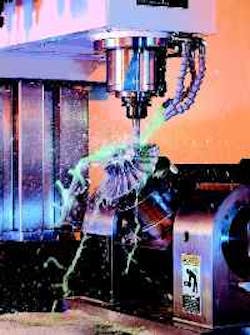Most shops with 3-axis machines don't realize they can do 5-axis machining.
Most shops think 5-axis machining involves a dedicated system, but adding a rotary table makes simultaneous 5-axis machining possible on a 3-axis machine. Shops can also investigate incorporating a spindle head instead.
Tilting rotary tables work well for 5-axis machining multiple sides of small, light parts.
Spindle-head attachments, like this Tri-Tech Model 5412, convert 3-axis machining centers to 5-axis systems.
At the mention of 5-axis machining, shopowners typically think of large, dedicated, expensive machining centers — fully interpolated for simultaneous cutting motion. But what many shops don't realize is that 5-axis machining is possible on a 3-axis machine by adding a tilting, 2-axis rotary table or spin-dle-head attachment. Probably the easiest and most affordable way shops can take advantage of the benefits of 5-axis machining is by adding a 2-axis, tilting-rotary table to a 3-axis machining center. In this setup, workpieces mount to a platen on the tilting-rotary table, which mounts to the bed of the machine. The table then positions parts at various angles for access to multiple part sides, which is especially useful for machining small, light parts.
The diameter of the platen on a tilting-rotary table places limits on the size and weight of the workpiece that can be mounted on it. Since a rotary table reduces work-envelope space, part size must be considered when selecting a machining center. However, work-envelope space can be maximized by using a machining center with an extended Z axis that increases allowable workpiece height.
Another option for shops wanting 5-axis capability is adding a spindle-head attachment. Large, programmable spindle-head attachments are typically designed to be permanently retrofitted to large gantry-style machines. But the cost for just the head can be over $175,000, which does not include custom fabrication and integration. Also the size and weight of large, programmable spindle heads make them incompatible with popular small to mid-sized machining centers.
Luckily, smaller, fully programmable spindle-head attachments are available. These heads provide a low-cost alternative and the ability to change from 3-axis to 5-axis mode in less than 30 min.
When coupling a rotary table or spindle-head attachment to a 3-axis machining center, shops need to consider the ability of the control to handle 5-axis operations. Many controls are not 5-axis capable, requiring installation of a new control, which is an expensive and notalways-optimum solution. An indexer control box is another solution; however, it does not enable simultaneous 5-axis machining.
Benefits of 5-axis machining
By far, the largest benefit of 5-axis machining is the reduction of cycle time through the elimination of manual positioning, limited tool changes, and increased accuracy for quicker cuts and fewer secondary operations.
With 5-axis machining, users can machine five sides of the part, and more if it is oddshaped, without special fixturing, jigs, or manually positioning the part. By eliminating manual repositioning, a shop can use a tool on each side of the part before loading the next tool — saving time if many tools are required.
Also, automatically positioning the part within repeatable tolerances improves machining accuracy, thus reducing secondary finishing operations.
Another benefit of 5-axis machining is the option of using a flat-bottom end mill to maintain perpendicularity on a complex surface. This lets shops set the stepover to the full diameter of the cutter, which dramatically reduces the required number of passes across a surface.
For example, a ballnose end mill might have a 0.02-in. stepover, but a 1 /2-in. flat-bottom end mill could be set for a 0.45-in. stepover. As a result, cycle time may be cut in half or more, while the ribbing caused by a ballnose end mill is eliminated, increasing the quality of the surface finish.
Other benefits of 5-axis machining include eliminating manual mill and hand operations when kellering with ballnose tools and machining complex parts not possible with a 3-axis machine, including undercutting and holes that must be normal to a complex surface.
In addition to reducing cycle times and improving accuracy, 5-axis machining expands a shop's capabilities by making a whole new category of work accessible — a category that tends to have fewer competitors and higher profitability.
A complete, affordable 5-axis packageFadal Machining Centers, Chatsworth, Calif., has partnered with Tri-Tech Products of Anaheim, Calif., to deliver a powerful 5-axis solution to shops that cannot justify owning a dedicated, simultaneous 5-axis machining center. Fadal manufactures a full line of machining centers with boxways that provide a rigid platform for 5-axis machining with attachments. The company also makes a control, the MP CNC, that regulates either simultaneous 5-axis machining or indexing without requiring an indexer control box. Fadal's machining centers are also available with an extended Z axis with boxways, which partially compensates for the loss of Z-axis travel when using a rotary table or spindle-head attachment. Coupling Fadal machining centers with a new generation of head attachments from Tri-Tech Products converts most 3-axis machines to simultaneous 5-axis machining. The Tri-Tech 5-axis head has a wide range of motion, including tilt capability of ±90° and continuous 360° rotary motion to access all points of the machining center's work envelope at any angle within the hemisphere. And the heads are removable for 3-axis machining operations. Fadal's MP CNC lets operators select the head from the control menu for 5-axis simultaneous and/or positioning operations. A 5-axis jog feature lets operators position the tilt and rotary axes to any position and then vector jog the X, Y, and Z axes along any vector for manual operations or extracting a broken tool from an angled hole. |
